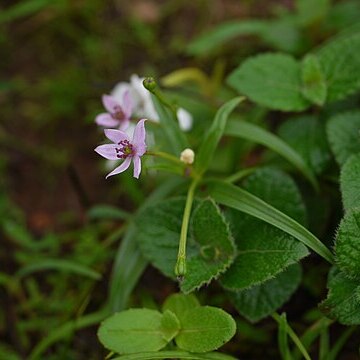Plants small, with a tunicated, bulb-like corm; stem erect, sometimes flexuous, simple, lowermost leaf or leaves a membranous, sheathing, tubular cataphyll, not protracted into a leaf-blade. Leaves spirally arranged, linear, sessile, basally sheathing the stem. Flowers solitary, axillary in the upper leaves or in a bracteate raceme; bracts linear; pedicel erect or recurved, sometimes elongating in fruit. Flowers small and inconspicuous, perianth segments free, linear to narrowly linear-lanceolate, spreading. Stamens free; filaments filiform, often thickened; anthers oblong, basifixed, versatile, dehiscing extrorsely by longitudinal slits. Ovary oblong; styles 3, free, short, strongly recurved. Capsule oblong to oblong-ovoid, loculicidal, papyraceous; seeds subglobose, papillate, with a distinct raphe.
Geophytic herbs; rootstock an ovoid tunicated corm. Leaves several, basal and cauline, with tubular or open sheathing bases, the upper sometimes subtending branches. Stem or scape simple or branched. Inflorescence a cyme, raceme-like, or a solitary terminal flower, irregularly bracteate. Flowers bisexual, regular, pedicellate. Tepals 6, in 1 whorl, similar, free, caducous, without nectaries. Stamens 6, inserted on receptacle, caducous; filaments filiform; anthers dorsifixed, versatile, longitudinally dehiscent, latrorse. Ovary superior, 3-locular, not angled; styles 3, free or connate up to 1/2 of length; stigmatic lobes recurved; ovules axile, several to many per locule. Fruit a loculicidal capsule. Seeds spherical or ovoid, brown, with prominent raphe.
Herbs perennial, cormous. Corm covered with a tunic. Stem erect, leafy. Leaves several, scattered, sessile, linear. Flowers solitary or several in a terminal corymb, small; bracts leaflike; pedicels long. Tepals 6, free, spreading, rather narrow, clawed, usually caducous. Stamens 6, inserted at base of tepals; filaments short, slightly flat; anthers versatile, extrorse. Ovary 3-loculed, ovoid to oblong; ovules many per locule. Style short, apically 3-lobed, adaxially stigmatic. Fruit a loculicidal capsule. Seeds many, subglobose; testa brown, thin.

